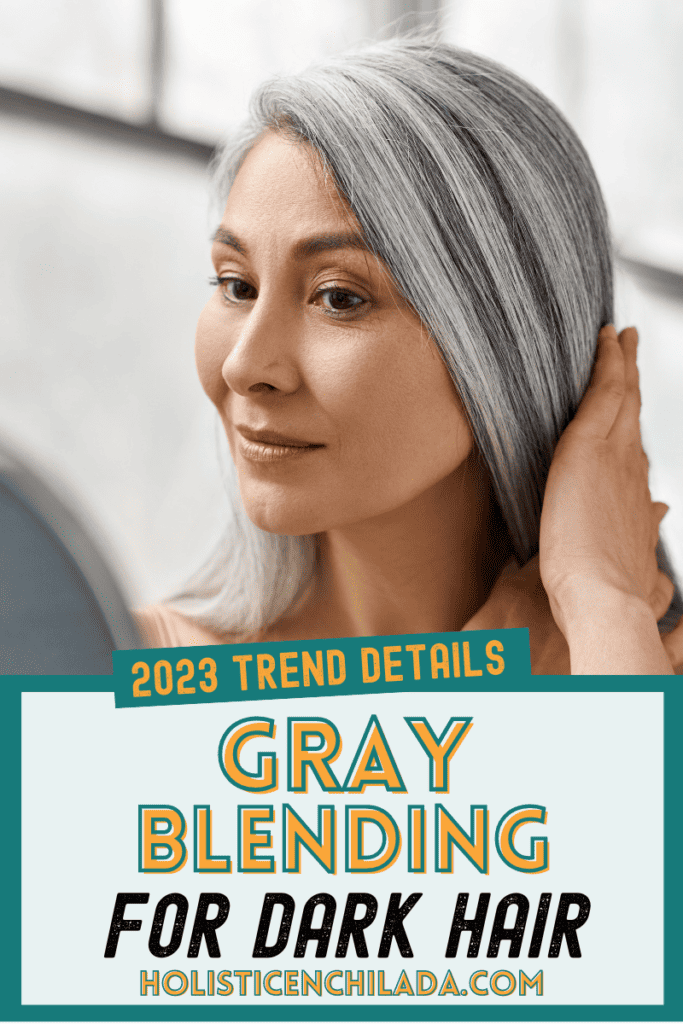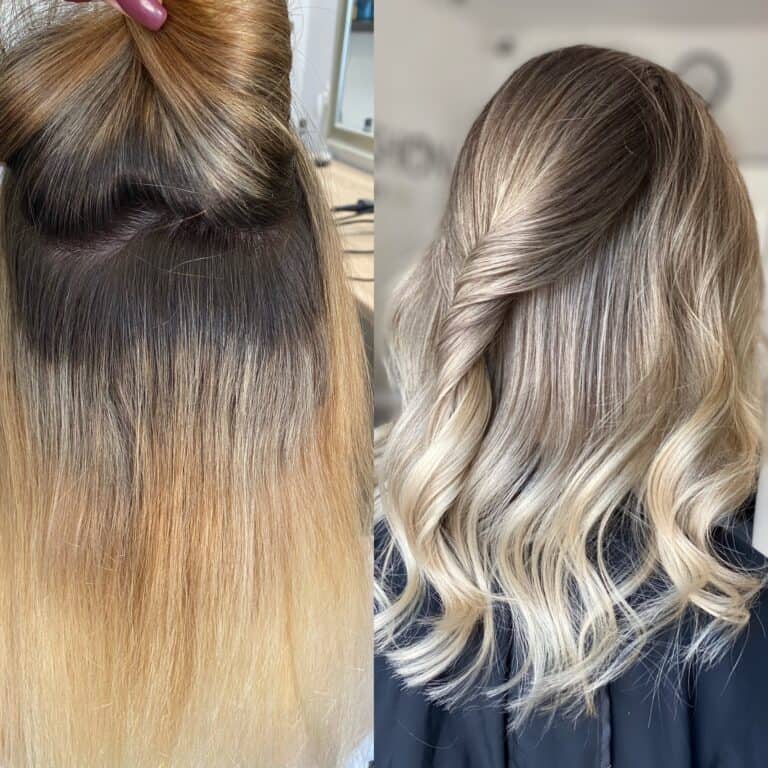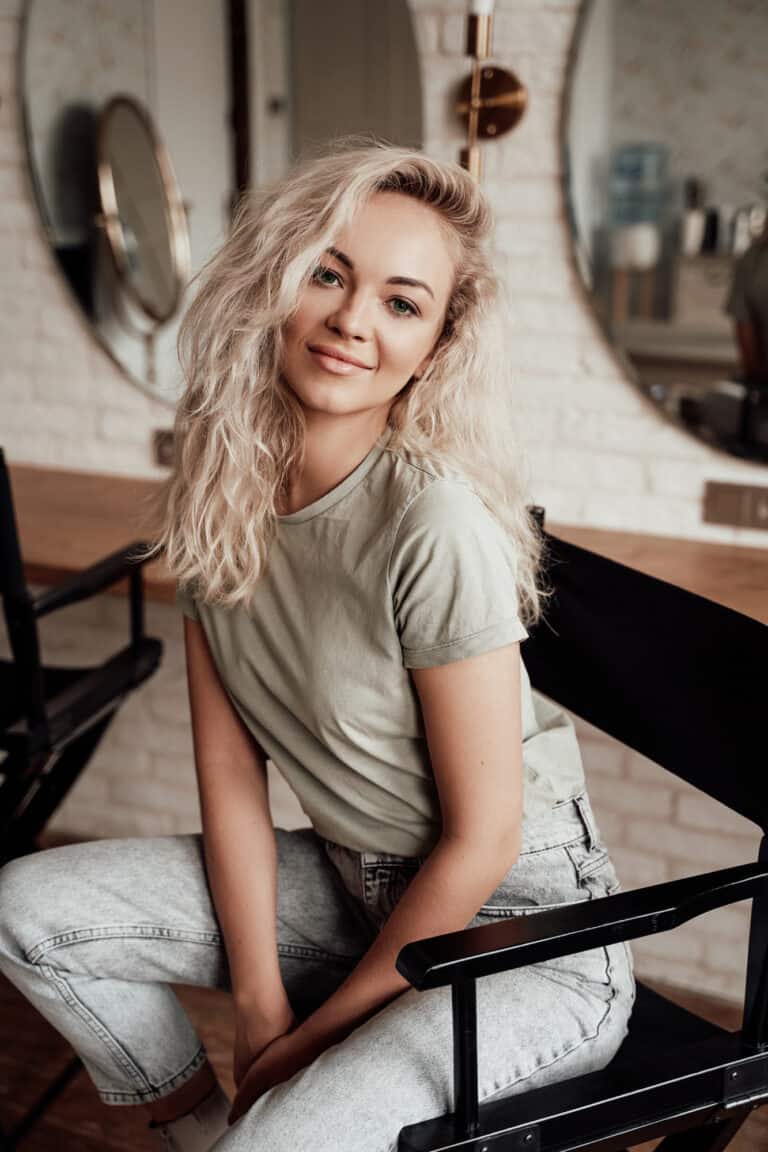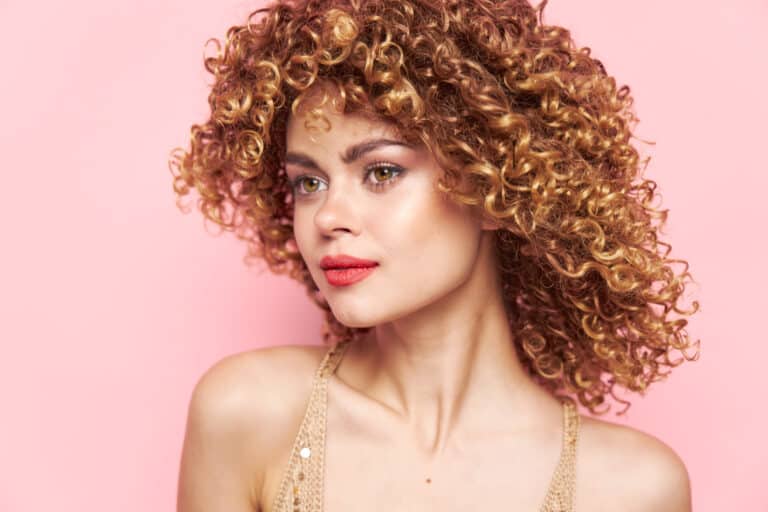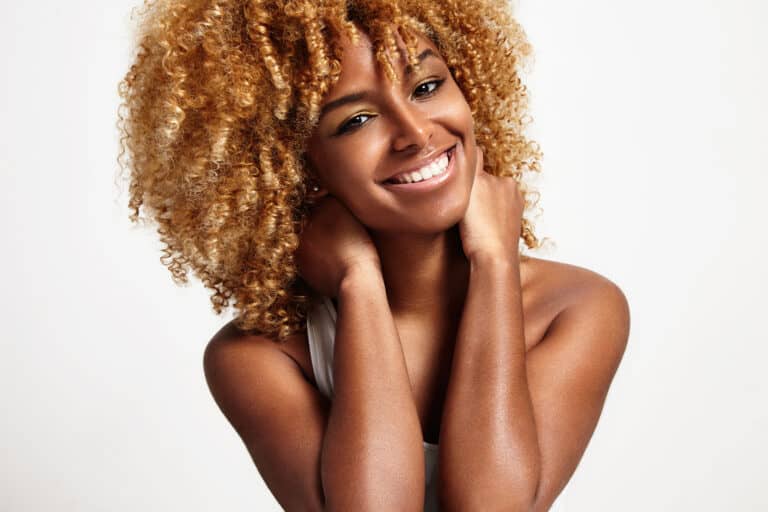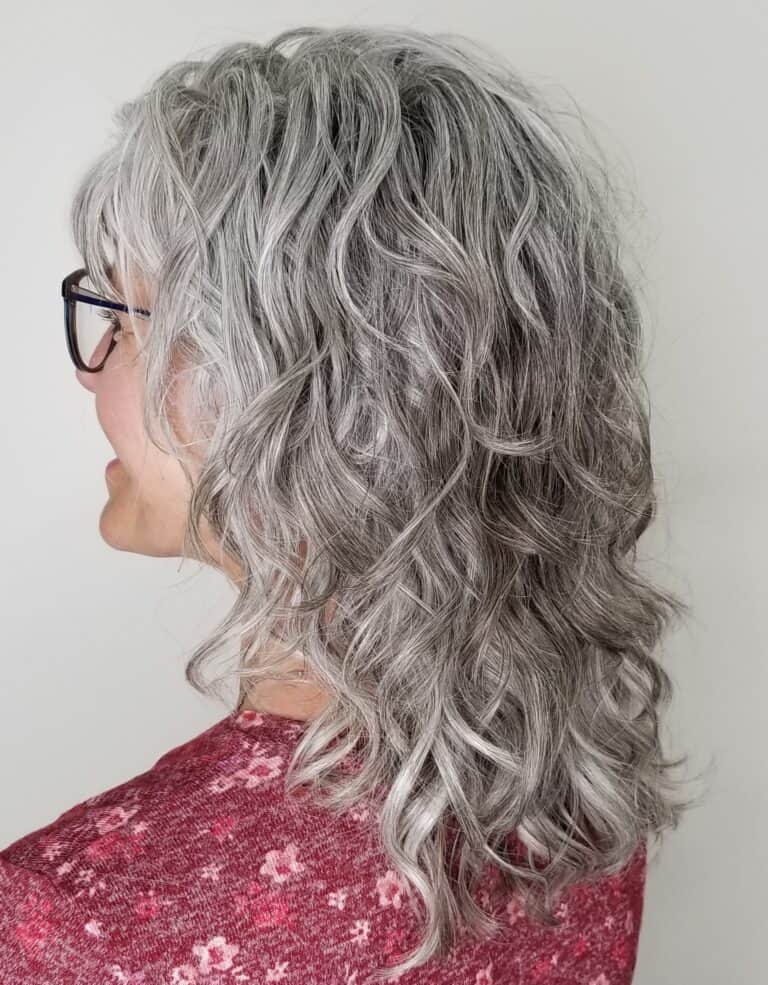Gray Blending for Dark Hair in 2023: Trend Details
This post may contain affiliate links, and I will earn a commission if you purchase through these links. Please read the disclosure policy for more details.
How do you feel about going gray? If you’re not quite ready to embrace your silver strands just yet, gray blending for dark hair could help you go gray gracefully.
Reaching for the box dye used to be the only way to color gray hair, but block coverage can look very harsh and needs regular maintenance. Modern gray blending techniques make dealing with gray hair easier, less damaging, and more flattering for your skin tone.
Whether you’ve just found your first grays or have reached the ‘salt and pepper’ look with flecks of silver throughout your hair, these clever coloring techniques can help you to transition to gray hair at your own pace.
This guide will help you to discover how to gradually go gray, the different techniques that are available, and the best products to look after your gray blended hair.
All About Gray Blending for Dark Hair
Gray blending is a way to combine your natural color and gray hairs for a flattering look. It adds complementary shades that fit with the natural colors of your hair to create beautiful texture and shade.
This technique means you can grow out colored hair without your gray hair growth at the roots looking messy.
It’s ideal if you’re not quite ready to go fully gray yet, or if you have only just started going gray and want a stylish way to incorporate your silver locks into your natural hair color.
Letting Your Hair Go Gray
Not everyone is ready to embrace gray at the first glint of a silver strand. But these days, there are more ways than ever to go gray gracefully and gradually. Searching for hashtags like #GoingGray or #GrayHair on Instagram brings up thousands of images with hundreds of likes, and there’s even a term, grombre, to describe the transition to silver locks.
Suddenly, silver hair has become a style choice, with some people choosing to enhance their grays or even have extra gray hairs added in. And more techniques and tools are available to make your transition from dark hair to gray as subtle or dramatic as you wish.
A few years ago, I interviewed Katie Emery of Katie Goes Platinum about her process embracing her curls. She talks about her transition and offers some advice to anyone considering taking the plunge.
Best Way to Transition to Gray Hair
Going gray is a gradual process, as production of the natural pigment melanin slows down and eventually stops, giving your locks a gray color.
For many years, women covered their gray with an all-over color, but this can look unnatural. It’s often difficult to grow out, and the color can look harsh against your skin tone, which also changes with age.
The growing popularity of the body positive movement has led many women to embrace their silver hair. This has coincided with the development of gray blending techniques as a way of transitioning to gray hair more gently.
How Gray Blending Transforms Your Hair
Gray blending mixes your natural hair color and silver hairs with complementary shades, to create a subtle blend that celebrates your silver strands.
The color treatment can be tweaked over time as you develop more gray for a gentler transition into gray hair. You’ll be able to get used to your changing look rather than trying to hide it, which is a powerful form of self-acceptance.
Advantages of Gray Blending
Gray blending is a great way to soften the look of your initial silver hairs, allowing you to get used to them gently. It’s more subtle than an all-over color, so you won’t have a harsh line where your roots start to grow out.
Grey blending is a pretty low maintenance look and can give your hair incredible shine and movement. It is also gentler than an all-over permanent color on coarse, dry graying strands.
Cons of Gray Blending Techniques
Gray blending doesn’t have many disadvantages, however, it can take multiple visits to the salon to achieve your final result. Gray blending is only a temporary measure and the cost can soon add up when you are scheduling regular color treatments.
And gray blending doesn’t completely cover up grays, so it doesn’t suit everyone.
Gray Blending Methods
Gray blending is a low-maintenance hair color technique. It helps you to transition to gray by incorporating colors that complement your natural hair color.
For the best possible results, it’s essential to find a stylist with plenty of experience in gray blending. They’ll be able to create a personalized color treatment to suit your hair color and condition, the amount of gray hair you have, and how much gray you want to be included in your final look.
Best Colors to Cover Gray Hair
Grey hair is already drier and coarser than pigmented strands, so they struggle to hold onto the color pigments in permanent dye. So if you want to use an all-over color to blend with your grays, it’s better to use a semi or demi-permanent hair dye. These deposit color on the outside of the gray strands and are less damaging than permanent hair colors, a major benefit for dry, coarse gray hair.
Choosing a lighter shade of your natural tone will make the gray less visible, so go for a pale brunette, ash brown, golden brown, or light auburn for a seamless look.
Balayage vs. Highlights vs. Lowlights
These are the three main gray blending techniques, and each has advantages and disadvantages.
Foil highlights and lowlights allow the gray hairs to blend into the base hair color. The highlights or lowlights can be concentrated around the hairline, which gives a natural effect as this is where most women first start graying. But it can be hard to cover a large area with highlights and lowlights, and they won’t give full gray coverage.
Balayage can cover a larger area and gives a more natural look. It’s also easier to customize the look by spot-treating areas, which is handy if you need more coverage in particular areas. The transition at the root is more natural looking than with highlights.
Balayage Transition to Gray Hair
Balayage is a fantastic technique for gray blending because you can either camouflage your grays or illuminate them depending on the shades you choose. Cool tones like ash gray will bounce light away from your natural grays so they become part of your overall look, while silver and ice blonde balayage will draw attention to your natural silver hairs.
Either way, balayage gives a natural look that’s easy to maintain or grow out if you change your mind.
Growing Out Gray Hair With Highlights
Blending gray hair with highlights for dark hair will show off your silver streaks in a way that complements your natural color. Your grays become a glamorous part of your look instead of something to conceal.
If you only have a few gray hairs, you can try baby highlights, which is a subtle coloring technique. If your amount of gray hair is more significant, classic silver highlights would work better for you, and you could try having highlights placed around your face for a brightening effect.
Highlights are very easy to maintain. You will only need to have them touched up every three to four months, compared to every few weeks for an overall color.
Transition to Gray Hair With Lowlights
Using low lights on gray hair instead of highlights to blend grays and darker hair can give you a more dramatic look. You’ll still avoid a harsh regrowth line, but the low lights will add depth and lift the grays while still looking more natural.
Choosing lowlights will create a multi-tonal look and give your locks a darker tone overall.
How to Ask for Gray Blending at the Salon
Your first step is to speak to your stylist about gray blending, highlights, lowlights, or balayage. But it’s important to remember that gray blending is not simple and not all colorists are experienced in this technique. If your stylist can’t help, it’s better to find an experienced colorist at a different salon.
How to Blend Gray Hair With Dark Brown Hair at Home
Although you’ll get the best results by visiting an experienced colorist, it’s possible to achieve gray blending at home if you are comfortable applying highlights yourself.
You’ll need to use a mix of bleach and developer, and you should plan out your highlights before starting to apply the bleach. Place the thickest highlights so that they frame your face, and add thinner highlights as you move up toward your crown. Placing highlights closer together will give a lighter effect overall.
Use a rattail comb to pick out thin sections of hair, then paint on the bleach and wrap in foil to stop the bleach from transferring onto other sections. You might need help with the back of your head.
Once you’ve washed out the bleach, use a purple toner to remove any yellow undertones that the bleach leaves behind, and then you can apply a gray semi-permanent dye. You’ll only see the color on the highlights, so don’t worry about it getting on the rest of your hair.
Grey Hair Blending Tips from A Stylist
Products for Gray Blending
One of the best ways to maintain the look of your gray blended hair is to use specialist products designed to look after colored hair. Regular shampoos and conditioners will fade the color quickly, sending you back to the salon for a refresh much sooner.
Shampoos for Gray Blending
Look for color-safe shampoos that will keep your color looking vibrant for longer. You could also try using color-depositing shampoos to refresh your color or toning shampoos to remove any brassy tones.
Nexxus Color Assure Shampoo and Conditioner
These color-safe hair care products contain Elastin Protein and Quinoa, to nourish your tresses and replace the proteins lost during coloring. They are salon-quality products that will extend the life of your color and keep your locks shiny and full of life.
Bold Uniq Purple Shampoo
This plant-based, vegan, and cruelty-free shampoo deposits purple pigments on lightened strands to refresh the color between salon visits. It’s sulfate-free and contains plant-based oils to soften your mane.
Jhirmack Purple Shampoo and Conditioner
Purple toning shampoo will remove yellow tones from gray hair, as purple and yellow are opposite each other on the color wheel. This purple shampoo is enriched with collagen and macadamia nut oil to moisturize coarse gray hair, while the conditioner contains collagen and green tea extract to add shine and soften your locks.
Conditioners for Gray Blending
As well as using a regular conditioner after shampooing, gray hair will benefit from a weekly deep conditioning treatment. This will keep your color looking great while softening and strengthening your hair.
Arvazallia Argan Oil Mask
This hair mask is an ideal deep conditioner for dry and damaged locks. It’s sulfate- and paraben-free, so it’s excellent for colored and textured hair. It also contains argan oil that nourishes your locks, leaving them strong and silky-soft.
Colored Hair Products
Although highlights and lowlights damage your hair less than an all-over color, your hair will still benefit from regular intensive treatments. Protein and bond treatments will help improve the texture of your hair and make it easier for it to hold color.
SUNATORIA Keratin Hair Mask
This rich hair mask is enriched with keratin, Vitamin E, and Omega 3 and 9, making it a deeply nourishing treat for damaged hair. It will repair and condition your locks, restoring shine and bounce to stressed locks and leaving your hair looking healthy.
5 Examples of Gray Hair Transformation
Check out the pictures and videos below showing different gray hair transformations on dark hair.
Gray Blending for Dark Hair: The FAQs
If you’re still keen to find out more about gray blending and gray hair, here are some of the most frequently asked questions on the topic:
What Causes White Hair?
The melanocyte cells in your hair follicles produce two types of melanin: eumelanin and pheomelanin. The proportions of these two pigments determine your hair color. Black hair and brown hair contain mainly eumelanin, while blonde hair has very little eumelanin and red hair has a mix of pheomelanin and a little eumelanin.
As we age, melanocyte cells stop producing this natural pigment, resulting in the hair strands losing their color. There is very little melanin in gray hair, and white hair contains none at all.
So what is the primary cause of gray hair?
Age is a significant reason, while genetics contributes to this natural phenomenon too. As well as the natural aging process, other factors like smoking, stress, and some medical conditions can also cause gray or white hair.
Is Gray Blending Right for Me?
Gray blending is ideal for anyone who wants to embrace their new gray hairs and blend them beautifully with their original hair color. It is more gentle on your hair than applying an all-over dye and is easier to maintain, so you’ll need fewer visits to the salon for color touch-ups.
It’s also a really great way to get used to the idea of gray hair and embrace this new phase in your life.
How Expensive Is Gray Blending?
The cost of gray blending will vary depending on several factors, including your location, the color technique used, and how experienced your stylist is.
How to Pick a Stylist for Gray Blending?
If you’re new to the gray blending technique, it’s usually better to visit a professional stylist to get the right color pattern and style for your hair.
The key to a good result is finding an experienced colorist who is skilled in this technique. A personal recommendation is best, but you could also use online reviews to help you decide.
TLDR: How to Grow Out Gray Hair Gracefully
Now that we don’t all immediately run for the box dye at the first sign of silver hair, growing out gray hair has become a genuine style option. But if you don’t totally love your grays just yet, there are coloring techniques that can help you to embrace your grays gradually.
Gray blending is a fantastic way to combine the natural shades of your hair with complementary tones for a flattering look. Techniques like balayage, highlights, and lowlights will allow you to go gray at your own pace and in the most stylish way possible.
Want to remember this? Save Gray Blending for Dark Hair to your favorite Pinterest board!
